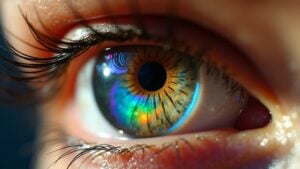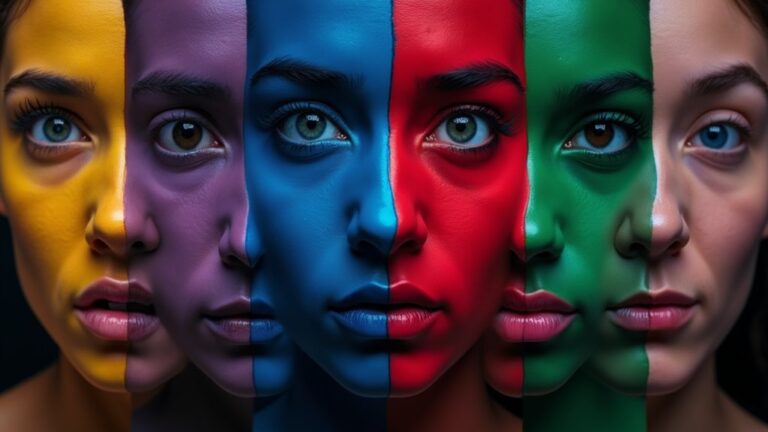Vision psychology examines how the way we see shapes the way we contemplate, comprehend, and recollect. The eyes capture light, sending signals to the brain, which deciphers patterns, colors, and motion—turning raw data into meaningful experiences. This process influences memory retention, learning efficiency, and even emotional reactions, like how a familiar face sparks joy or a dark room triggers unease. Beyond biology, culture and context shape interpretations, making visual perception deeply personal. Apprehending these connections reveals why certain images persist in the mind while others fade—and how design, education, and therapy can harness this power.
The Biological Foundations of Visual Perception
Though the world seems effortlessly visible, the biological processes behind sight are complex and finely tuned. Visual perception begins when light enters the eye and strikes the retina, where specialized cells called rods and cones convert it into electrical signals. Rods work best in dim light, while cones detect color and sharp details, especially in the fovea—the retina’s high-resolution zone.
These signals travel through the optic nerve to the brain’s visual cortex, where visual processing assembles them into a coherent image. The brain interprets shapes, colors, and movements to create the scenes we “witness.” Each step relies on precise coordination, and even small disruptions can alter perception. Comprehension of this system highlights how delicate and remarkable human vision truly is.
Cognitive Mechanisms Behind Visual Processing
The brain processes visual information through specialized neural pathways that detect features like color and motion. Memory plays an essential role in interpreting visual stimuli, shaping how we recognize and respond to what we see.
These cognitive mechanisms work together to construct a coherent perception of the world.
Neural Pathways in Vision
As light enters the eyes, it sets off a complex odyssey through the brain’s neural pathways, transforming raw visual input into meaningful information. The visual system begins when light hits the retina, sending signals via the optic nerve to the thalamus, which relays them to the visual cortex.
Here, specialized neurons decode edges, motion, and colors, forming the foundation of visual perception. From there, the brain splits processing into two streams. The dorsal (“where”) pathway maps an object’s location and movement, while the ventral (“what”) pathway identifies shapes and details.
This division guarantees vision and visual perception work seamlessly, blending spatial awareness with recognition. Comprehending these pathways helps explain how the brain stitches together the world we see. Each step is precise, making certain clarity and depth in every glance.
Memory and Visual Stimuli
Human brains are wired to recall imagery better than language, thanks to specialized neural mechanisms that rapidly process and preserve visual particulars. The visual cortex efficiently encodes key details, enhancing memory through perception.
Studies show people remember visuals more clearly than words, with working memory typically holding just 3-4 items. Pairing verbal information with illustrations strengthens recall, as the brain links both formats. Repeated exposure to familiar patterns boosts recognition speed over time.
Vision plays a critical role because the brain prioritizes spatial and pictorial input, making visual learning highly effective. To improve memory, focus on vivid graphical representations, associate concepts with images, and limit overload by breaking visuals into smaller chunks. Simple strategies leverage the brain’s natural strengths for sharper retention.
Neural Pathways and Visual Information Integration
Photoreceptors in the retina capture light, kicking off a complex expedition where visual information travels through the optic nerve to the thalamus and primary visual cortex. The brain interprets this sensory information by breaking down visual stimuli into components like color, motion, and shape. These details are then integrated into a cohesive representation, allowing us to understand and interact with our surroundings.
Parallel Processing: The visual cortex handles different aspects of sight simultaneously, like edges and textures, before combining them.
Feedback Loops: Higher brain areas refine initial visual signals, adjusting how we perceive details based on context.
Multisensory Integration: Visual data merges with other senses, creating a fuller experience of the world.
This seamless process guarantees we navigate life with clarity and precision.
How Visual Input Shapes Memory and Learning
Visual input travels through specific eye-brain pathways to form and reinforce memories quickly.
Strong visual cues, like colors or patterns, help trigger recall by linking new information to existing knowledge.
Repeated exposure to visual material strengthens learning, making it easier to retain concepts over time.
Eye-Brain Memory Pathways
Because the brain relies heavily on what the eyes take in, visual input plays a major role in how memories form and stick. Whenever individuals see something, the back of the brain processes visual information, integrating it with existing knowledge. The brain’s ability to store and recall details depends on how well these pathways function.
Visual Cortex Processing: Light signals become meaningful images in the visual cortex, which later link to memory networks.
Hippocampus Integration: This region connects sights with experiences, strengthening recall through emotional or spatial context.
Attention Matters: Focused viewing improves memory encoding, while distractions weaken it, affecting learning efficiency.
Disruption in these pathways, like in Alzheimer’s, shows how critical vision is for memory-building. Boosting attention and engagement can augment retention.
Visual Cues Enhance Recall
As memories form, the brain often leans on what the eyes capture, weaving visual details into the fabric of recall. Studies show pairing words with images boosts retention by up to 75%, as vision and memory work together.
The brain processes visuals faster than text, making charts, diagrams, or even visualize scenes powerful tools for learning. Structured notes like mind maps engage visual pathways, improving exam performance by 15-20%.
Even conjuring related scenes can strengthen recall by 30%, proving the eye’s role in shaping memory. Visual cues activate both sight and sound processing, creating stronger mental imprints. Whether through flashcards, graphs, or mental imagery, leveraging visual input helps the brain store and retrieve information more effectively.
Learning Through Visual Repetition
Repetition strengthens memory, and as soon as combined with visual input, the effect becomes even more powerful. Vision research shows the human brain processes repeated visual cues faster, embedding them deeper into long-term memory.
The brain’s ability to retain information received through sight relies on patterns—seeing something multiple times reinforces neural pathways, making recall effortless. Parts of the visual system, like the occipital lobe, work with memory centers to solidify learning.
- Colorful cues: Bright or contrasting visuals stick better, helping the brain prioritize what’s pressing.
- Spaced repetition: Revisiting visuals over time, not all at once, improves retention.
- Context matters: Pairing images with familiar settings or stories makes them memorable.
Visual repetition isn’t just about seeing—it’s about creating lasting connections in the mind.
Emotional Responses Triggered by Visual Stimuli
As people see something—whether it’s a bright red stop sign, a frightening image, or a breathtaking painting—their brains react almost instantly, sparking emotions before they even fully process what they’re looking at. Light, shapes, and colors play a pivotal role in these emotional responses.
Warm hues like red or orange often evoke excitement or urgency, while cool tones like blue or green tend to create calm. High contrast visuals, such as sharp black-and-white patterns, can heighten tension or alertness. Even subtle shifts in color saturation or brightness influence moods, from joy to unease.
These reactions happen rapidly, bypassing conscious thought, as the brain decodes visual cues tied to survival or pleasure, shaping immediate feelings without deliberate analysis.
Cultural and Contextual Influences on Visual Interpretation
Visual interpretation isn’t just about what the eyes see—it’s shaped by culture, context, and personal experience. Cultural backgrounds influence how people perceive colors, symbols, and even spatial relationships. Contextual factors like lighting or surrounding objects can alter the meaning of what’s observed, while societal norms dictate which visual details are noticed. Emotional states and personal biases further skew perception, leading to selective attention or misinterpretation.
Cultural symbols: A gesture or color might hold different meanings across cultures, affecting how it’s understood.
Situational cues: The same object in a museum versus a garage may be interpreted differently due to context.
Personal history: Past experiences shape how familiar or unfamiliar visuals are processed, altering reactions.
These layers of influence make visual interpretation a deeply subjective process.
Applications of Vision Psychology in Human-Centered Design
Because the brain processes visuals faster than text, designers who understand vision psychology can create experiences that feel effortless. Applying gestalt principles like similarity and proximity helps users group information intuitively, while color blindness considerations boost accessibility. Depth perception cues, such as shadows, guide interactions spatially. Human-centered design benefits from insights into receptor cells, which determine how we perceive contrast and detail. By using visual hierarchy—like bold colors or large fonts—designers direct attention effectively, improving user experience.
| Design Principle | Psychological Benefit |
|---|---|
| Gestalt Grouping | Reduces cognitive load |
| High Contrast | Supports low vision |
| Clear Hierarchy | Speeds task completion |
| Consistent Icons | Augments recognition |
These strategies optimize designs to align with natural visual processing, making interfaces both functional and appealing.
Age-Related Changes in Visual Perception and Cognitive Impact
Several age-related changes affect how the eyes and brain process visual information, shaping daily experiences in ways many don’t anticipate. Over time, the lens stiffens, leading to presbyopia—a common struggle with reading or close-up tasks. Reduced contrast sensitivity makes it harder to distinguish objects in low light, while glare from bright lights becomes more disruptive.
Visual acuity declines, blurring details and complicating activities like driving. These shifts don’t just strain the eyes; they also demand more cognitive effort, slowing reaction times and increasing fatigue.
- Presbyopia: The lens loses flexibility, making near vision fuzzy.
- Glare sensitivity: Bright lights create discomfort, especially at night.
- Contrast issues: Shadows and similar colors blend together, reducing clarity.
Understanding these changes helps adapt environments and routines to support aging vision.
Conclusion
Vision psychology reveals how deeply sight intertwines with our thoughts and emotions, like roots shaping a tree’s growth. The brain deciphers visual cues, guiding memory, learning, and feelings, while culture and age refine this process. By comprehending these connections, we access ways to design better experiences and support mental well-being. Ultimately, vision isn’t just about seeing—it’s about how the world shapes our inner lives.





